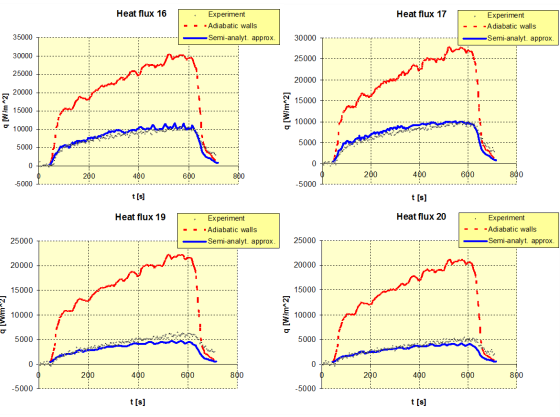Transient numerical simulations of a fire in an enclosure (1/3 the ISO room size) were performed
to develop and to validate a transient semi-analytical treatment of the heat transfer
in the walls. The setup closely followed one of the experiments performed by Tofilo et al [1].
As in the experiments, methanol was used as a fuel. The fuel source at the back left corner
of the enclosure was represented by a time dependent mass inflow.
To model the flow turbulent behaviour, the Shear-Stress Transport (SST) model was selected.
Thermal radiation was modelled with the Discrete Transfer model. In our case 24 rays were
used in radial and in azimuthal direction. A multigrey gas model was used to take into account
the temperature and pressure dependencies of radiative absorption and emission from gases.
For combustion modelling, the Eddy-Dissipation combustion model was selected. An additional effort
was invested to develop a semi-analytical model of the wall thermal response.
A detail description of the modelling approach can be found in [2].
Wall heat flux analysis for ventilation controlled fire in an enclosure
Temperatures and heat fluxes were recorded at the multiple locations on the wall opposite
the fire. Matching these values with the experimental data over the whole period of the
experiment was the main challenge of the modelling validation exercise.

Heat flux readings for gauge 16, 17, 19 & 20 [2]
The comparison shows a good agreement between both sets of results over the whole period
of fire development. The CFD model predicts well thermal conditions in the upper (hot)
and in the lower (cold) layer. Nevertheless, it is important to mention that the thickness
of the hot layer is slightly underpredicted.
References
- P. Tofilo, M.A. Delichatsios, G.W.H. Silcock, Effects of the Fuel Sootiness on the Wall Heat Fluxes in Enclosure Fires, Proceedings, 8th IAFSS Symposium, Beijing, China, 2005, pp. 987-998.
- A. Horvat, Y. Sinai, P. Tofilo, Semi-Analytical Treatment of Wall Heat Transfer Coupled to a Numerical Simulation Model of Fire, Num. Heat Transfer, Part A, 2009, Vol. 55, Issue 6, pp. 517-533.
Dr Andrei Horvat
M.Sc. Mechanical Eng.
Ph.D. Nuclear Eng.
phone
+44 79 72 17 27 00
skype
a.horvat
e-mail
mail@caspus.co.uk
M.Sc. Mechanical Eng.
Ph.D. Nuclear Eng.
phone
+44 79 72 17 27 00
skype
a.horvat
mail@caspus.co.uk

